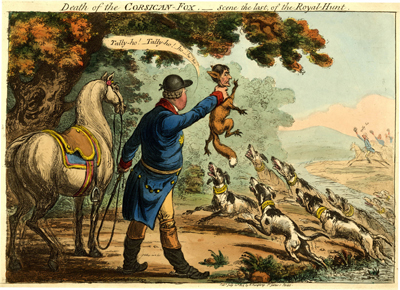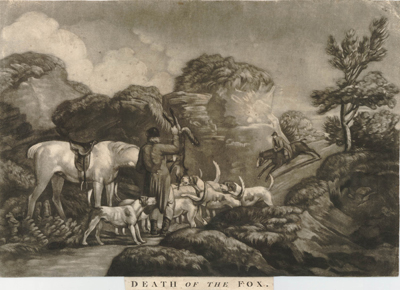Death of the Corsican-Fox
This print parodies a number of popular hunting prints on the death of the fox, in which the hunter surrounded by his dogs holds up the dead fox for all to see. Often these hunting prints were part of a series based on paintings commemorating a specific occasion with recognizable portraits such as Viscount Weymouth's Hunt by John Wooton. Gillray alludes to these traditions in the extended title of his print: Death of the Corsican-Fox._Scene the Last, of the Royal-Hunt.
Supposedly the final print of a series, the hunter is King George holding a still-live "Corsican Fox (Napoleon Bonaparte) while the King's attack dogs come in for the kill. The dogs (as indicated by the writing on their collars) include [John Jervis 1st Earl of] St Vincent', '[Horatio] Nelson', '[Admiral William] Cornwall[is]', 'Sydney S[mith]', '[Alan] Gardner',—all Admirals in the Navy responsible for preserving British dominance on the high seas. The cry "Tally Ho! Tally Ho! Ho Ho Ho" is both an expression of delight and an alert to the other members of the hunt that the fox has been found. William Pitt (out of office at the time of this print, but a strong supporter of a more aggressive stance against Napoleon) leads the chase in the background.

© Trustees of the British Museum
Appearing, according to the publication date on July 20, 1803, the print does not commemorate a specific event, but seems instead (by putting him in the "dead center" of the print) to be creating a rallying cry against Napoleon. In May of 1803, supported by Pitt, Britain had terminated the Treaty of Amiens and redeclared war against France resuming a struggle that had gone on for 10 years. To suggest, however, that in July Britain now had Napoleon by the throat was, to put it mildly, an exaggeration. The title is the first clue to Gillray's intentions. Napoleon is now a "Corsican Fox," a small and frightened animal from a small island, not the all-powerful general who would within a year announce himself as Emperor of France. King George holds him easily aloft, standing next to a Hanoverian steed beneath a spreading English oak tree, enjoying one of England's most enduring pastimes. In every way, then Gillray has chosen to minimize the ferocity and success of the French foe and to emphasize the symbols of British strength, the Hanoverian succession, and the persistence of a British way of life. It is wishful thinking at the start of a new phase in the war against France.
Gillray's print was certainly inspired by the whole genre of hunting scenes which was growing in popularity and would become a staple of English print-making into the Victorian age. But I suspect he may have had in mind one specific print—the 1798 mezzotint The Death of the Fox published by Haines & Son. Unlike every other print that I have seen on the death of the fox which shows the successful hunter facing the viewer, this one, like Gillray's shows him facing away. And again like Gillray's, he is standing with his horse by his side with another hunter galloping in the distance.

Haines & Son
[February 1, 1798]
© Trustees of the British Museum
Sources and Reading
- Commentary from the British Museum on Death of the Corsican-Fox.
- Draper Hill, Mr. Gillray The Caricaturist, 1965. p.128n
- "George III of the United Kingdom," Wikipedia
- "Napoleon," Wikipedia
- "John Jervis, 1st Earl of St Vincent," Wikipedia
- "Horatio Nelson, 1st Viscount Nelson," Wikipedia
- "William Cornwallis," Wikipedia
- "Sidney Smith (Royal Navy officer)," Wikipedia
- "Alan Gardner, 1st Baron Gardner)," Wikipedia
- Thomas Wright and R.H. Evans, Historical and Descriptive Account of the Caricatures of James Gillray #280
- Thomas Wright and Joseph Grego, The Works of James Gillray, the Caricaturist; With the History of His Life and Times p. 299
Comments & Corrections
NOTE: Comments and/or corrections are always appreciated. To make that easier, I have included a form below that you can use. I promise never to share any of the info provided without your express permission.